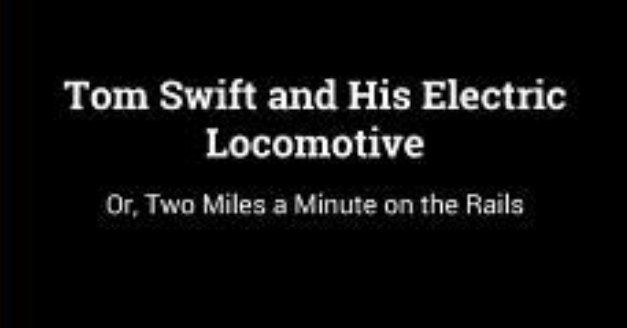CHAPTER I — Tom Swift and His Electric Locomotive
byCHAPTER I – Tom Swift and His Electric Locomotive begins not with gears turning or engines roaring, but with an unexpected visit that hints at urgency and ambition. Mr. Richard Bartholomew, a determined man representing the Hendrickton and Pas Alos Railroad, arrives at the Swift home with a request that is as bold as it is risky. His company, battling fierce competition and financial instability, needs a revolutionary solution. Facing a powerful rival railroad led by the resourceful and, as he describes, ruthless Montagne Lewis, Bartholomew knows conventional upgrades will no longer suffice. The mountains his line crosses are harsh, the terrain unforgiving, and coal-based locomotives are not efficient enough. He proposes an ambitious idea: a high-speed electric locomotive capable of two miles per minute that can perform reliably across the toughest routes.
Tom and his father, Barton Swift, listen with increasing interest. The offer is more than just technical; it’s wrapped in confidentiality, competitive pressure, and the potential to reshape the future of rail transportation. Bartholomew doesn’t sugarcoat the risks. He suspects his rival has spies who may already be monitoring this new development, perhaps even within his own ranks. To show he’s serious, Bartholomew offers $25,000 up front to fund the prototype, with a further incentive of $100,000 and guaranteed bulk orders if the Swifts succeed within two years. This is not just a business transaction. It’s a strategic partnership in a high-stakes industrial showdown. For the Swifts, the offer presents both a thrilling challenge and a heavy responsibility.
Tom is captivated. He sees not only the technical hurdles but also the opportunity to push electric rail technology beyond anything currently on the market. He’s aware that other electric trains exist—such as the well-known Jandel model—but their speeds are limited and performance drops significantly on steep or uneven routes. Bartholomew’s request isn’t just to improve; it’s to leap ahead of the curve. Tom begins sketching ideas in his mind, thinking about advanced motors, energy-efficient drivetrains, and enhanced power distribution. He envisions dynamic systems that can adapt to changes in terrain without sacrificing speed. The dream isn’t only to meet Bartholomew’s expectations—but to exceed them with an invention that could lead the entire industry in a new direction.
Barton Swift, always measured in his approach, considers the practicalities. He’s seen the highs and lows of technological ambition and knows how easily innovation can attract danger. His advice to Tom is clear: embrace the project, but remain cautious. The elder Swift raises questions about security, discretion, and how they might protect their plans from prying eyes. Bartholomew confirms those concerns, recounting how rivals like Lewis are known to play dirty—using spies, bribery, and even threats to disrupt progress. That revelation doesn’t deter Tom. If anything, it hardens his resolve. He suggests they begin working immediately—but under strict confidentiality, using only trusted personnel and encrypted documentation.
The family workshop, long a place of creativity and invention, becomes the focal point of something much larger. Tom begins drafting the first concept diagrams in shorthand only he and his father can fully interpret. The project will require not only brilliance but also security and secrecy. Materials must be sourced quietly, and testing must be done in private. Tom also begins planning the infrastructure needed: a testing track, control equipment, and voltage systems strong enough to support sustained high-speed performance. Every detail matters—from the weight of the locomotive to its wheel traction on steep inclines. Failure is not an option—not just for their own reputation, but because an entire railroad’s future may rest on their success.
Bartholomew’s passion for the project comes not just from competition but from a belief in modernizing rail travel. He explains how rising fuel costs and operational inefficiencies are making traditional locomotives increasingly unsustainable. Electrification, he believes, is not just the next step—it is the only path forward. With electricity, maintenance costs drop, fuel supply becomes more predictable, and environmental impact is lessened. For Bartholomew, this isn’t just about saving his company; it’s about setting a precedent. And he believes Tom Swift is the only person with the innovation, integrity, and technical ability to make it happen.
The conversation ends with all parties aligned but aware of what lies ahead. Tom accepts the challenge, excited by both the technical puzzle and the chance to shape the future of rail transportation. Barton agrees as well but reminds Tom of the importance of discretion. Plans are made to formalize the agreement within a few days, and Bartholomew leaves, expressing gratitude and guarded optimism. As the Swifts watch him go, they’re not celebrating just yet. There’s a sense that something bigger is brewing—something that will demand more than blueprints and engines. It will require strategy, protection, and perseverance.
As Tom closes the workshop for the night, his mind remains focused. He isn’t just thinking about speed or torque. He’s thinking about how this machine—once built—might change the world’s perception of what electric railways can do. And more urgently, he’s thinking about how to keep the project safe from those who fear that change.

